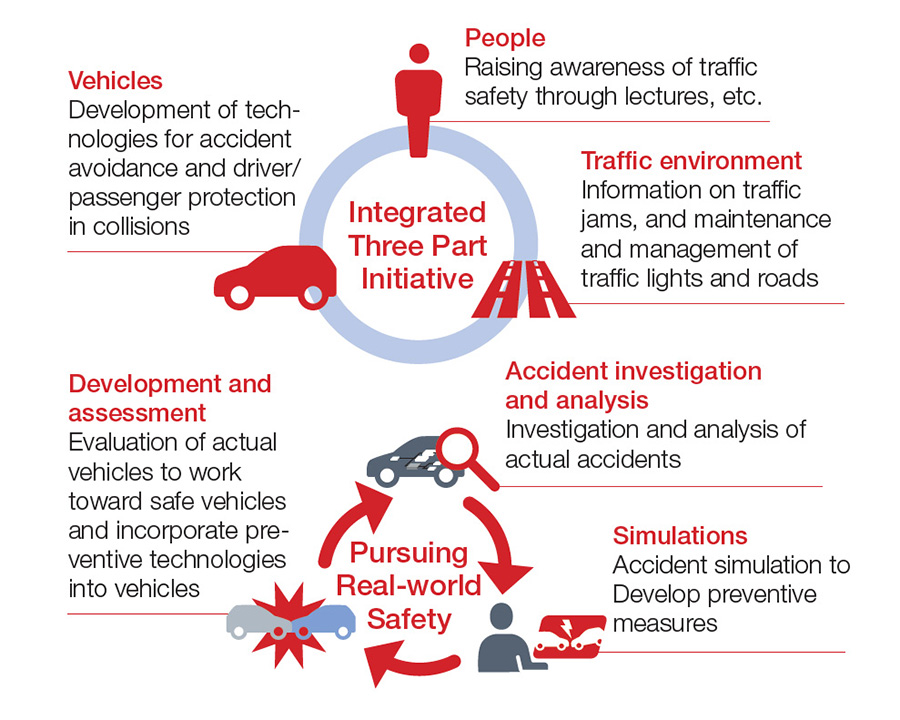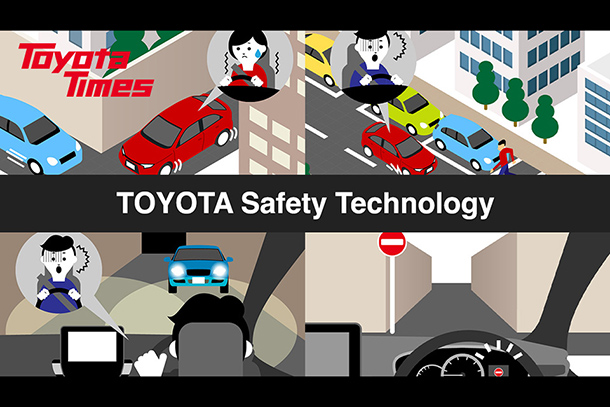Initiatives to Improve Safety
Fundamental Approach
For Toyota to achieve its ultimate goal of eliminating traffic accident causalities, the development of safe vehicles is, of course, important, but it is also essential to educate people, including drivers and pedestrians, and to ensure safe traffic infrastructure, including traffic signals and roads.
To achieve a safe mobility society, Toyota believes it will be important to implement an integrated three-part initiative involving people, vehicles, and the traffic environment, as well as to pursue real-world safety by learning from actual accidents and incorporating that knowledge into vehicle development.
Toyota has defined its Integrated Safety Management Concept as the basic philosophy behind its technologies for eliminating traffic casualties and is moving forward with development.
Integrated Safety
Management Concept Toyota provides optimized driver support for reasonable safety at every stage of driving, from parking to normal operation, the moment before a collision, during a collision, and post-collision emergency response. We also aim to enhance safety by reinforcing links between vehicle safety systems, rather than thinking about each system as a separate component. These are the approaches behind our Integrated Safety Management Concept.
Active Safety
The Toyota Safety Sense system packages multiple active safety functions that help reduce serious traffic accidents causing death or injury. The major functions Pre-Collision Safety (PCS), which assists in avoiding and mitigating damage from collisions with cars ahead or pedestrians; Lane Departure Alert (LDA), which contributes to preventing accidents caused by leaving the lane of travel; and Automatic High Beam (AHB), which helps ensure optimal forward visibility during nighttime driving.
Since its market launch in 2015, Toyota Safety Sense has been installed in more than 40.5 million vehicles globally (as of July 2023). Toyota Safety Sense is now available on nearly all passenger car models (as standard or option) in the Japanese, U.S., and European markets. It has also been introduced in a total of 144 countries and regions, including such key markets as China, other select Asian countries, the Middle East, and Australia.
Passive Safety
Passive safety combines vehicle bodies that absorb the energy of collisions with devices that provide support to protect drivers, passengers, and pedestrians and thereby minimize collision damage.
In 1995, in the pursuit of world-leading safety, Toyota created its own stringent internal target related to passive safety performance called "Global Outstanding Assessment (GOA)" and developed a collision-safety body structure and passenger protection devices. Since then, Toyota has continued to evolve GOA, striving to improve the real-world safety performance of its vehicles in a wide variety of accidents.
To analyze vehicle-related injuries, Toyota collaborated with Toyota Central R&D Labs., Inc. to develop the Total Human Model for Safety (THUMS), a virtual human body model. THUMS is being used in the research and development of a variety of safety technologies, including seat belts, airbags, and other safety devices, as well as vehicle structures that mitigate injuries in accidents involving pedestrians. Toyota made the THUMS software available on its website free of charge in January 2021 in the hope that as many users as possible will benefit from it.
Emergency Response
Every minute counts in the response to an accident or medical emergency. In the event of an accident or medical emergency, Toyota's HELPNET® emergency reporting system service contacts a dedicated operator that then contacts police, fire, or ambulance services to ensure the rapid dispatch of emergency vehicles. HELPNET® automatically contacts an operator when the airbags deploy and supports D-Call Net®, a service that makes quick deployment decisions for air ambulances. This service is provided by sending vehicle data to the HELPNET center from an on-board data communication module (DCM).
Automated Driving Technologies
Toyota has been engaged in the research and development of automated driving technologies since the 1990s. The Mobility Teammate Concept is an automated driving concept unique to Toyota that seeks to enhance communication between drivers and their cars, enabling them to assist one another in coordinated driving as companions. Rather than cars taking over driving from people and replacing them, drivers and cars act as partners to protect one another so that drivers can enjoy the experience of driving while deferring to automated driving at times, achieving truly safe, secure, and unrestricted mobility.
The Lexus LS and Mirai models launched in April 2021 are equipped with Toyota/Lexus Teammate state-of-the-art driving assist technology, with some grades including Advanced Drive, a system that assists driving on an expressways or other motor-vehicle-only roadways. The Advanced Drive on-board system will appropriately detect the vehicle's surroundings, make decisions, and assist driving under the driver's supervision according to actual traffic conditions. It can keep the vehicle in its lane, maintain the distance from other vehicles, navigate a lane split, change lanes, and overtake other vehicles until leaving the roadway for the destination. The system achieves high levels of safety and peace of mind, reducing driver fatigue and providing a pleasant journey to the driver's destination.
Deep learning-focused AI technologies support driving by predicting and responding to a wide variety of situations that could occur when driving. In addition, Advanced Drive uses software updates, allowing cars to stay up to date with the latest software via either a wireless or wired connection.
Cars have many uses, and needs continue to diversify. Accordingly, Toyota is advancing R&D into automated driving technologies not only for personally owned vehicles (POVs), but also in the field of mobility as a service (MaaS) for people and goods. Toyota is one of the first companies to launch advanced automated driving technology for vehicles sold to corporate customers. Data collected from these vehicles will then be collected, analyzed, and fed back into development to further evolve automated driving technologies.
Raising Traffic Safety Awareness
Toyota carries out awareness-raising initiatives for drivers and pedestrians to help prevent traffic accidents.
One such initiative for drivers is the Toyota Driver Communication safe driving technique seminar held periodically at Toyota Safety Education Center Mobilitas, on the grounds of Fuji Speedway. For pedestrians, in cooperation with Toyota dealers across Japan, Toyota has been donating traffic safety teaching materials to kindergartens and nursery schools nationwide since 1969.


